Nylon
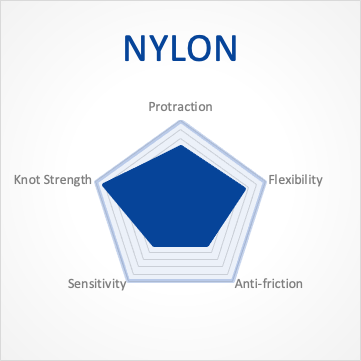
Characteristic of Nylon Fishing Line
A flexible and easy-to-use material with a wide range of applications.
A material that is hard to deform, and fit well on a reel and easy to use casting line. It also stretches slightly, so it can also be used as a shock leader to absorb the stress on a line. Although known for weakness to water absorption and ultraviolet rays damage, the recent development of manufacturing methods and coating technology dramatically improved durability.
VARIVAS Nylon Fishing Line Products
Learn more about our Nylon products.
Fluorocarbon
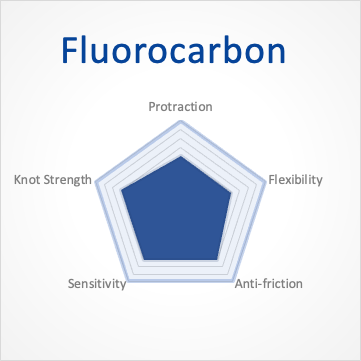
Characteristic of Fluorocarbon Fishing Line
Suitable for shock leader line, with strong abrasion resistance and good sensitivity.
The material has excellent anti-abrasion quality when it comes into contact with obstacles and provides good sensitivity.
It is commonly used for shock leader lines. The high specific gravity makes it effective for fast sinking fishing tackle and lures. Conventional fluorocarbon lines lack flexibility; however, VARIVAS’s innovations in materials and manufacturing have produced a more flexible Fluorocarbon.
VARIVAS Fluorocarbon Fishing Line Products
Learn more about our Fluorocarbon products.
PE | Braided Line
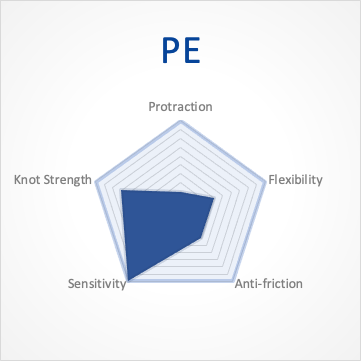
Characteristic of PE Fishing Line
With its overwhelming sensitivity, strength, and thinness, PE line has revolutionized fishing.
Its non-stretching strength results in sensitive feedback from the tip of the line. It is 2.5 to 3 times stronger than similar diameter sized nylon line. Some feel that PE line is weak against abrasion wear and is a bit too supple of a line.
‘PE’ refers to polyethylene, the original material used to make PE line. Today, however, VARIVAS’s PE products are engineered and manufactured by a complex combination of several different variations of high tech processing methods and special coatings to create a single ‘PE’ line.
VARIVAS PE | Braided Fishing Line Products
Learn more about our PE | Braided fishing line products.
Polyester
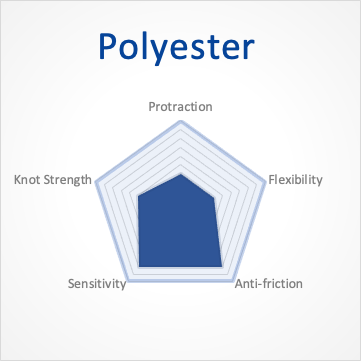
Characteristic of Polyester Fishing Line
Polyester / ‘Ester’ line provides very good sensitivity, and high specific gravity controls a delicate game.
It is very tenacious, hard, and has zero to low stretch compared to nylon and fluorocarbon lines. It is often used in hi-lo rig with multiple hooks and leaders. Polyseter / ‘Ester’ has no water absorption and is superior to nylon in abrasion resistance. Because of its high sensitivity and specific gravity, second only to fluorocarbon, thin diameter polyester/ester lines are now popular for Ajing (fishing for Aji) and stocked trout pond fishing competitions.
VARIVAS Polyester Fishing Line Products
Learn more about our Polyester Fishing Line Products
Construction of Fishing Line
There are two primary types and shapes of the fishing line:
-
single yarn, or monofilament, and
-
multiple yarn braided line, or multifilament line; also called PE.
Monofilament
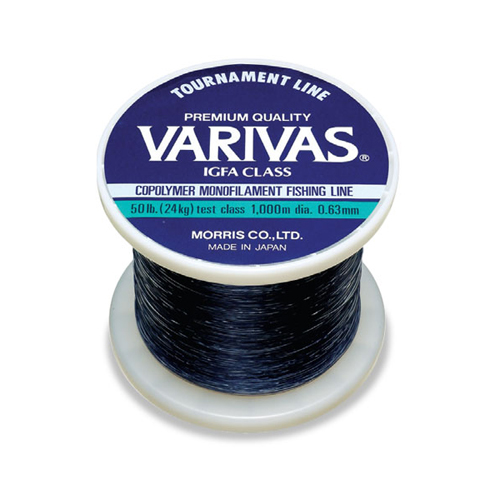
Monofilament
Monofilament lines are made from a single (mono) yarn (filament), produced by stretching a single fiber material. Specifically, nylon, fluorocarbon, and polyester correspond to the monofilament
Learn more about our Monofilament productsMultifilament
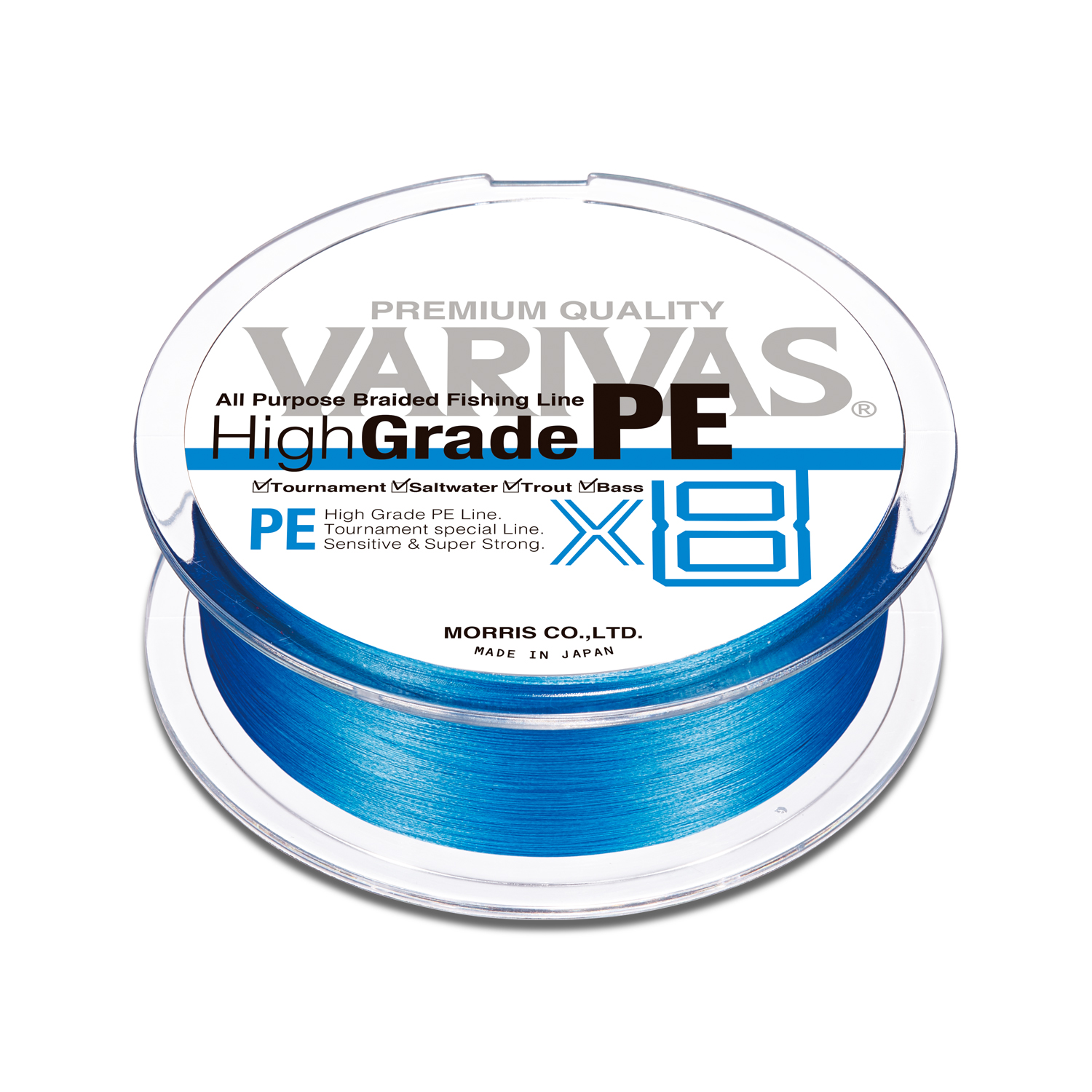
Multifilament
A thread made up of multiple yarns (filaments). Often refers to as PE line, because it’s woven with polyethylene fiber. Polyethylene fiber is not suitable as a single line, thus is woven with other materials.
Learn more about our Multifilament | PE | Braided productsTensile Strength
What is ’tensile strength’?
Strength under a constant load.
The tensile strength is also called linear strength and means the strength when a constant load is applied to the line. A dedicated measuring instrument is used for the tensile strength test. First, one end of the line is attached to the instrument, and then the load is slowly applied, and the value at the time when the line is broken represents the load strength.
Specific Gravity
 What is ‘specific gravity’?
What is ‘specific gravity’?
Buoyancy of the fishing line.
For example: PE line floats, fluorocarbon line sinks.
Specific gravity shows how much weight the fishing line has compared to water. For example, when ‘water’ is designated as 1, line with a number 1.5 or higher is heavier than water and sinks. Conversely, line with a number of 0.5 is lighter than water and floats on the surface of the water. PE line of 0.97 completely floats above water. Nylon with an approximate number of 1.14 drifts in water. Fluorocarbon, which has a high specific gravity of about 1.76, will sink.
Anglers use different fishing lines by taking advantage of each characteristic according to fishing.
Knot Strength
What is the ‘knot strength’?
 Knot strength is the indication of the strength of the line, when tied.
Knot strength is the indication of the strength of the line, when tied.
Knot strength is represented by the weight at the time when the line is tied and the force of pulling is gradually applied in order to break the line.
Why is this important?
When tied, the strength of the line may be reduced in half. With stretchable nylon, even if a knot is tied in the line, the strength is only reduced by about 10%. Fluorocarbon is slightly weaker than nylon. (The numerical value may vary depending on the manufacturing method and binding method.)
Water Absorption
What is ‘water absorption’?
Water absorption is the degree to which the line absorbs water.
Nylon has high water absorption, resulting in the need to pay attention to deteriorating performance due to water absorption. The key is to choose a line with a high-quality coating that does not absorb water.
Elongation
What is ‘elongation’ or stretch?
 Elongation or Stretch indicates how far the line is stretched when it is overloaded.
Elongation or Stretch indicates how far the line is stretched when it is overloaded.
For example, if a 1-meter line extends 10cm, it’s elongation or stretch rate is 10%.
The average elongation/stretch of nylon is 25%-35%. Fluorocarbon averages 23%-30% elongation/stretch. And PE averages 5% or less.
Why is this important?
The less elongation (or stretch), the higher the line’s sensitivity.
Although the difference between Nylon and Fluorocarbon seems small, Fluorocarbon has a low initial elongation right after the load is applied, so the sensitivity during actual fishing is high.
Abrasion Resistance
What is ‘abrasion resistance’?
The ability to maintain strength by preventing the surface of the line from being scratched or damaged when the line rubs against obstacles is called abrasion resistance.
Although it may differ in different conditions, Fluorocarbon line has high abrasion resistance when rubbed against sharp objects. Fluorocarbon is thus a great choice when fishing in places with many obstacles. Nylon comes in second, and PE is known to be weak. Due to advances in line materials and coating technologies, the abrasion resistance of all fishing lines, however, is generally improved today.
Refractive Index
What is ‘refractive index’?
Refractive index is the reason why fluorocarbon is inconspicuous in water.
When light travels into water and hits the line some of the light is transmitted through the line and some is reflected. Transmitted light through the line does not travel straight, but changes its direction. The rate of this change is called the refractive index.
Refractive index is indicated by the ratio of the incident angle and the refraction angle. The larger the refractive index, the more reflected light and the more conspicuous in water. The refractive index of water is 1.33. The refractive index of nylon is 1.58, fluorocarbon is 1.42, and PE is 1.54.
Fluorocarbon line is inconspicuous in water because it’s refractive index is close in value to that of water.
Light Resistance
What is ‘light resistance’?
The light of fluorescent lamps also has an effect.
Depending on the type of fishing line, the performance of the line may deteriorate due to exposure to light. Of course, the effect of sunlight is most significant, but even fluorescent lamps also affect it, so be careful with the handling. Fluorocarbon and PE line have very good light resistance, so there are few problems, but Nylon line deteriorates quickly when exposed to light. For example, it is necessary to take sufficient precautions such as storing in light blocking film or in a case that blocks light.

